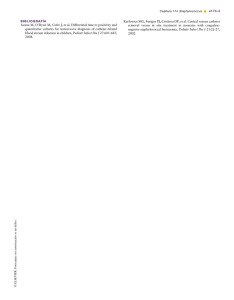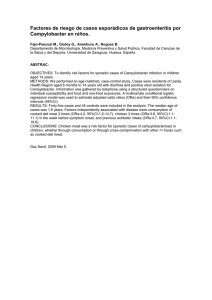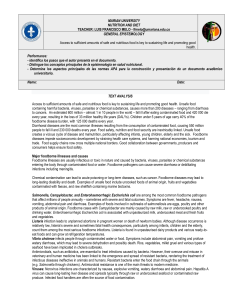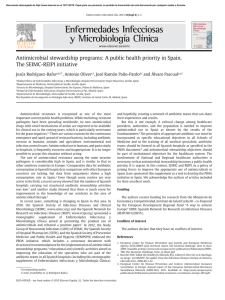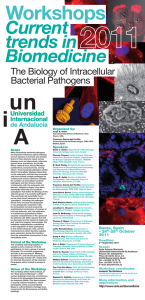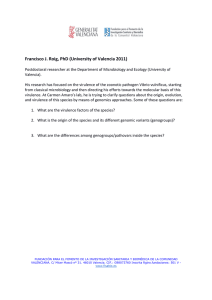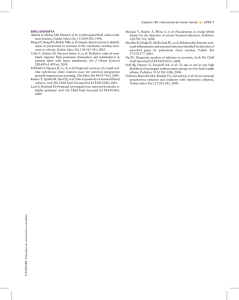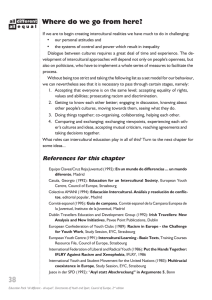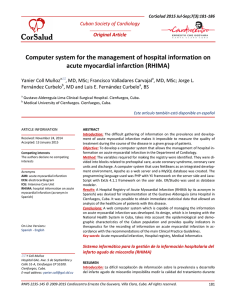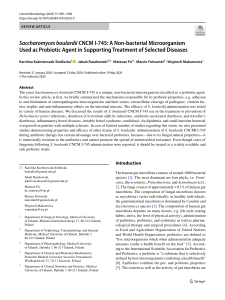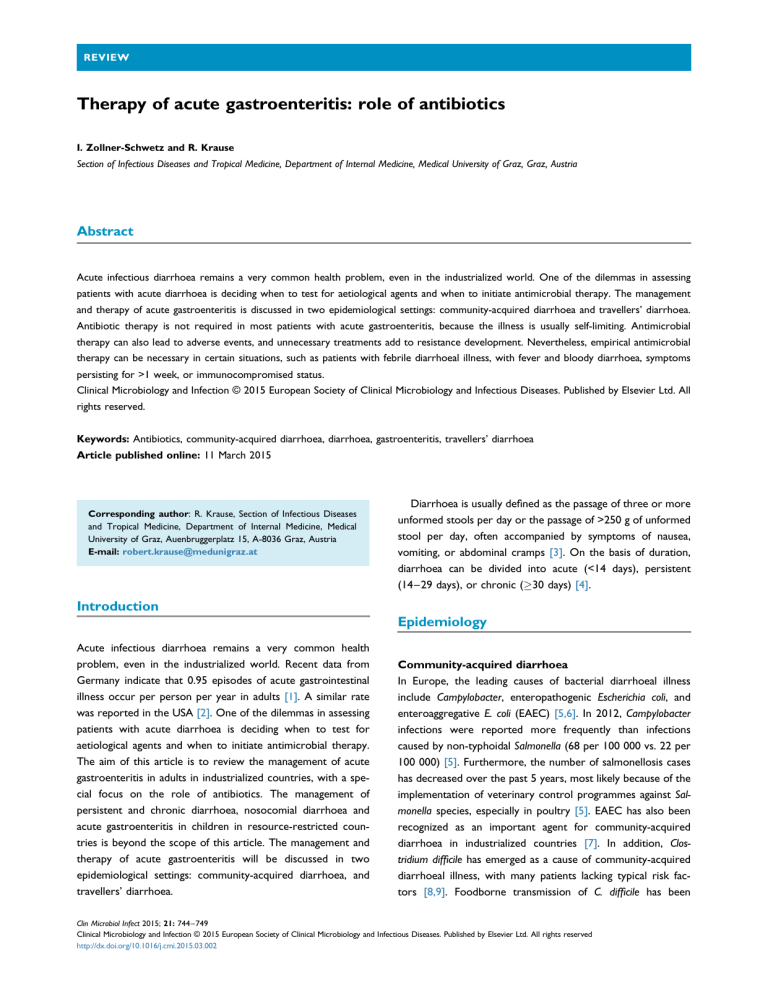
REVIEW Therapy of acute gastroenteritis: role of antibiotics I. Zollner-Schwetz and R. Krause Section of Infectious Diseases and Tropical Medicine, Department of Internal Medicine, Medical University of Graz, Graz, Austria Abstract Acute infectious diarrhoea remains a very common health problem, even in the industrialized world. One of the dilemmas in assessing patients with acute diarrhoea is deciding when to test for aetiological agents and when to initiate antimicrobial therapy. The management and therapy of acute gastroenteritis is discussed in two epidemiological settings: community-acquired diarrhoea and travellers’ diarrhoea. Antibiotic therapy is not required in most patients with acute gastroenteritis, because the illness is usually self-limiting. Antimicrobial therapy can also lead to adverse events, and unnecessary treatments add to resistance development. Nevertheless, empirical antimicrobial therapy can be necessary in certain situations, such as patients with febrile diarrhoeal illness, with fever and bloody diarrhoea, symptoms persisting for >1 week, or immunocompromised status. Clinical Microbiology and Infection © 2015 European Society of Clinical Microbiology and Infectious Diseases. Published by Elsevier Ltd. All rights reserved. Keywords: Antibiotics, community-acquired diarrhoea, diarrhoea, gastroenteritis, travellers’ diarrhoea Article published online: 11 March 2015 Corresponding author: R. Krause, Section of Infectious Diseases and Tropical Medicine, Department of Internal Medicine, Medical University of Graz, Auenbruggerplatz 15, A-8036 Graz, Austria E-mail: robert.krause@medunigraz.at Diarrhoea is usually defined as the passage of three or more unformed stools per day or the passage of >250 g of unformed stool per day, often accompanied by symptoms of nausea, vomiting, or abdominal cramps [3]. On the basis of duration, diarrhoea can be divided into acute (<14 days), persistent (14–29 days), or chronic (30 days) [4]. Introduction Epidemiology Acute infectious diarrhoea remains a very common health problem, even in the industrialized world. Recent data from Germany indicate that 0.95 episodes of acute gastrointestinal illness occur per person per year in adults [1]. A similar rate was reported in the USA [2]. One of the dilemmas in assessing patients with acute diarrhoea is deciding when to test for aetiological agents and when to initiate antimicrobial therapy. The aim of this article is to review the management of acute gastroenteritis in adults in industrialized countries, with a special focus on the role of antibiotics. The management of persistent and chronic diarrhoea, nosocomial diarrhoea and acute gastroenteritis in children in resource-restricted countries is beyond the scope of this article. The management and therapy of acute gastroenteritis will be discussed in two epidemiological settings: community-acquired diarrhoea, and travellers’ diarrhoea. Community-acquired diarrhoea In Europe, the leading causes of bacterial diarrhoeal illness include Campylobacter, enteropathogenic Escherichia coli, and enteroaggregative E. coli (EAEC) [5,6]. In 2012, Campylobacter infections were reported more frequently than infections caused by non-typhoidal Salmonella (68 per 100 000 vs. 22 per 100 000) [5]. Furthermore, the number of salmonellosis cases has decreased over the past 5 years, most likely because of the implementation of veterinary control programmes against Salmonella species, especially in poultry [5]. EAEC has also been recognized as an important agent for community-acquired diarrhoea in industrialized countries [7]. In addition, Clostridium difficile has emerged as a cause of community-acquired diarrhoeal illness, with many patients lacking typical risk factors [8,9]. Foodborne transmission of C. difficile has been Clin Microbiol Infect 2015; 21: 744–749 Clinical Microbiology and Infection © 2015 European Society of Clinical Microbiology and Infectious Diseases. Published by Elsevier Ltd. All rights reserved http://dx.doi.org/10.1016/j.cmi.2015.03.002 CMI Zollner-Schwetz and Krause hypothesized as a possible source of community-associated infections; however, the evidence needed to confirm or refute this hypothesis is incomplete [10,11]. Other less common pathogens include Yersinia species, non-cholera Vibrio species and Shiga toxin-producing E. coli (STEC) strains. In 2011, there was a nationwide outbreak of STEC O104:H4 in Germany, resulting in >4000 infections and >900 cases of haemolytic–uraemic syndrome (HUS) [12,13]. The outbreak was traced back to contaminated sprouts [12]. In 2012, STEC cases were reported at a rate of 1.5 cases per 100 000 in the EU [5]. Travellers’ diarrhoea Between 20% and 50% of travellers from industrialized countries to resource-restricted nations experience travellers’ diarrhoea, depending on the destination [14,15]. It is most often acquired in the first 2–3 weeks of travel, through the ingestion of contaminated foods and, less often, drinks [16]. A metaanalysis concluded that the incidence of diarrhoea was very similar in travellers who followed the advice ‘boil it, cook it, peel it, or forget it’ and those who engaged in more adventurous eating habits [17]. The majority of travellers have selflimiting illnesses; <1% require hospitalization [18]. Bacterial enteropathogens account for 80% of the cases of travellers’ diarrhoea [16]. Enterotoxigenic E. coli, enteroinvasive E. coli and EAEC are implicated in the majority of cases, followed by Campylobacter, Salmonella and Shigella [16]. Parasitic agents are uncommon causes of acute travellers’ diarrhoea, but should be suspected in the case of a subacute and chronic illness [19]. Management of acute gastroenteritis Most patients with acute diarrhoea are able to manage their illness, and do not seek medical attention. In patients with significant diarrhoeal illness, i.e. profuse, dehydrating, febrile or bloody diarrhoea, the first step for the attending physician consists of obtaining a thorough history, including epidemiological and clinical information. Relevant clinical features include onset of illness, the frequency of bowel movements, the presence of dysenteric symptoms (fever, tenesmus, or blood or mucus in the stool), symptoms of volume depletion, and associated symptoms such as nausea, vomiting, or abdominal pain [4]. Important epidemiological information includes previous international travel, treatment with antibiotics, chemotherapy, underlying immunosuppressive conditions, work at a day-care centre, and consumption of unsafe foods (e.g. raw meats, eggs, and shellfish). A directed physical examination is aimed at exploring the patient’s hydration status and abdominal tenderness. The determination of the precise cause of diarrhoea is not necessary in most cases of non-severe illnesses [3]. However, Therapy of acute gastroenteritis 745 any diarrhoeal illness lasting for >1 day accompanied by fever, recent use of antibiotics, duration of symptoms of >1 week, hospitalization, immunosuppression, diarrhoea in elderly patients or symptoms of dehydration (defined as dry mucous membranes, decreased urination, tachycardia, symptoms of postural hypotension, or lethargy) should prompt evaluation of faecal specimens for Salmonella, Campylobacter species, and Shigella species [4]. In cases with bloody stools, testing for STEC should be added to the panel of stool examinations [4]. Testing for C. difficile is recommended if the patient has a history of antibiotic intake, chemotherapy, or hospitalization [4]. It should be kept in mind that community-acquired cases of C. difficile infection in the absence of typical risk factors do occur [6,8,20]. In the majority of cases, the bacterial pathogen is detected in the first or second sample that is submitted [21], so performance of multiple cultures is not useful. Although the bacterial yield of stool cultures is quite low (1.5–3%) [22], the information obtained is important for both the individual patient and public health purposes. In the past 10 years, PCR-based diagnostic methods have evolved as novel tools, often detecting multiple enteropathogens in a single test [23,24]. These techniques offer the advantages of high sensitivity and, in the case of automated multiplex systems, of a very short turnaround time as compared with conventional culture [6]. However, detection of a pathogen’s nucleic acid does not automatically implicate this pathogen as the causative agent of clinical symptoms. The patient could be an asymptomatic carrier, or the pathogen’s nucleic acid may be detected although the pathogen is no longer viable. Combined approaches of PCR-based methods followed by culture in cases of positive results to detect resistance patterns could be a useful strategy in the future. It should be kept in mind that the patient’s history and symptoms rather than laboratory results alone constitute the determining factor regarding when to initiate antimicrobial therapy. Additional diagnostic evaluations, such as serum chemistry analysis, complete blood count, and blood cultures, may be necessary in patients who have fever or symptoms indicative of systemic inflammatory response syndrome [3]. Therapy The initial treatment of acute diarrhoeal illnesses must include rehydration, which can be achieved with oral electrolyte solutions or intravenous fluids. Antibiotic therapy is not required in most patients, because the illness is usually self-limiting. Any consideration of antimicrobial therapy must be carefully weighed against unintended and potentially harmful consequences [4]. Nevertheless, empirical and specific antimicrobial Clinical Microbiology and Infection © 2015 European Society of Clinical Microbiology and Infectious Diseases. Published by Elsevier Ltd. All rights reserved, CMI, 21, 744–749 746 Clinical Microbiology and Infection, Volume 21 Number 8, August 2015 therapy can be considered in certain situations. Knowledge of local patterns of resistance is crucial to reduce the number of treatment failures. There is concern about antibiotic treatment in patients with suspected or proven infection with STEC, because experimental models suggest an increase in the production and release of the toxin during treatment with fluoroquinolones [25]. This may lead to an increase in the risk of HUS when antibiotics are administered [26], although some studies have suggested that antibiotic treatment is not associated with an increased risk of HUS [27]. Several studies have shown a correlation between antibiotic use and the risk for HUS [26,28], including a large, prospective study among 259 children [29]. STEC infection should be suspected in patients with bloody diarrhoea, abdominal pain or tenderness in the absence of fever [26,30]. Therefore, in an outbreak of bloody diarrhoea, antibiotics are not currently recommended for patients with little or no fever who may have STEC infection [3]. In general, single cases of acute febrile bloody diarrhoea are more likely to be caused by pathogens such as Campylobacter species or Shigella species, depending on the epidemiological setting. These patients are likely to benefit from empirical antimicrobial therapy [3]. Community-acquired diarrhoea A Swedish study demonstrated that empirical treatment with norfloxacin reduced the intensity and, to some extent, the duration of diarrhoeal symptoms, although the effect was restricted to patients who were severely ill [31]. However, treatment with norfloxacin delayed the elimination of Salmonella and induced resistance in Campylobacter [31]. A meta-analysis confirmed that antimicrobial therapy does not reduce the length of illness in otherwise healthy patients with non-severe diarrhoea caused by non-typhoidal Salmonella [32]. In addition, antimicrobial therapy tended to increase the period during which Salmonella was detected in stools [32]. Therefore, antimicrobial therapy is not necessary in patients with non-severe nontyphoidal salmonellosis who are otherwise healthy [3]. In Europe, Campylobacter infections were three times more frequent than infections caused by non-typhoidal Salmonella in 2012 [5,6]. Resistance to ciprofloxacin was as high as 44% in Campylobacter isolates from humans in some states of the EU, whereas resistance to erythromycin was <5% [33]. In contrast, only 5–13% of non-typhoidal Salmonella isolates were resistant to ciprofloxacin in Europe in 2011, depending on the serovars [33]. A recent study estimated that approximately one-fifth of Campylobacter cases in the USA are associated with international travel in the week before onset of symptoms [34]. Among international travel-associated cases, 60% of the Campylobacter isolates were resistant to fluoroquinolones, as compared with 13% of the non-travel-associated cases [34]. Although it seems unreasonable to suggest fluoroquinolones as CMI first-line empirical therapy for community-acquired diarrhoea in European countries, this class of antibiotics may be effective in non-travel-associated cases in the USA. The use of azithromycin seems reasonable in international travel-associated cases in the USA and in community-acquired cases in Europe. Empirical antimicrobial therapy is recommended in selected patient groups: six or more stools per day, with fever and bloody diarrhoea or fever only, symptoms persisting for >1 week, or immunocompromised status. In Europe, treatment options include azithromycin, fluoroquinolones, and trimethoprim–sulfamethoxazole (Fig. 1). The use of fluoroquinolones and trimethoprim–sulfamethoxazole should be avoided in pregnant women. In some patients with an established infectious cause of acute diarrhoea, organism-specific antimicrobial therapy may be necessary. The treatment options have recently been summarized [3]. Travellers’ diarrhoea It is important to remember that the majority of patients with travellers’ diarrhoea have self-limiting illnesses, and that <1% require hospitalization [18]. However, antibiotic treatment is warranted to treat those with moderate to severe diarrhoea (more than four stools per day, fever, and blood or mucus in the stool). Traditionally, ampicillin, trimethoprim–sulfamethoxazole and doxycycline have been used as the drugs of choice [35]. However, high levels and frequencies of resistance were reported for these substances, making them inappropriate as empirical therapy [36]. Currently, three substances are recommended to travellers as self-medication: ciprofloxacin, azithromycin, and rifaximin [19] (Fig. 2). The increasingly frequent resistance to fluoroquinolones among enteropathogens worldwide is of growing concern, particularly concerning Campylobacter isolates from Southeast Asia [37], but also in Europe [33]. Rifaximin, a non-absorbed rifamycin, was shown to be effective in the treatment of travellers’ diarrhoea caused by non-invasive pathogens [38]. It has also been used successfully as a prophylactic agent in travellers from the USA visiting Mexico [39]. Although rifaximin is non-absorbed, it has been demonstrated that rifampin-resistant staphylococci emerge after the intake of rifaximin [40]. As rifampin resistance is associated with treatment failure in staphylococcal foreign-body infections, rifaximin should be used prudently, especially in patients at risk for such infections. Azithromycin, a modern macrolide antibiotic, was more effective than levofloxacin for the treatment of travellers’ diarrhoea in Thailand [41]. A study performed in Turkey comparing azithromycin and loperamide with levofloxacin and loperamide led to similar results [42]. A single oral dose of 1000 mg was more successful than administration of 500 mg once daily for 3 days, although the single-dose regimen tended to be more frequently associated with mild nausea after intake [41]. Clinical Microbiology and Infection © 2015 European Society of Clinical Microbiology and Infectious Diseases. Published by Elsevier Ltd. All rights reserved, CMI, 21, 744–749 CMI Zollner-Schwetz and Krause Therapy of acute gastroenteritis 747 FIG. 1. Management of community-acquired diarrhoea. Note that Shiga toxin-producing Escherichia coli (STEC) infection should be suspected in patients with bloody diarrhoea, abdominal pain or tenderness in the absence of fever. Antimicrobial therapy is not recommended for patients with suspected or proven STEC infection. FIG. 2. Management of travellers’ diarrhoea (adapted from [19]). Antibiotic treatment is warranted in cases of moderate to severe diarrhoea (more than four stools per day, fever, or blood or mucus in the stool). In travellers with severe symptoms accompanied by fever, azithromycin is the treatment of choice, because of the lack of a systemic effect of rifaximin and increasing resistance to fluoroquinolones, especially in Campylobacter species. Conclusion Antibiotic therapy is not required in most patients with acute gastroenteritis, because the illness is usually self-limiting. Nevertheless, in community-acquired diarrhoea, empirical antimicrobial therapy should be considered in selected patient groups, such as patients with fever and bloody diarrhoea or febrile diarrhoeal illness, symptoms persisting for >1 week, or immunocompromised status. In patients with travellers’ diarrhoea, antimicrobial therapy is recommended in cases of moderate and severe disease. Knowledge of local patterns of resistance is crucial to reduce the number of treatment failures. Transparency declaration The authors declare that they have no conflicts of interest. Clinical Microbiology and Infection © 2015 European Society of Clinical Microbiology and Infectious Diseases. Published by Elsevier Ltd. All rights reserved, CMI, 21, 744–749 748 Clinical Microbiology and Infection, Volume 21 Number 8, August 2015 References [1] Wilking H, Spitznagel H, Werber D, Lange C, Jansen A, Stark K. Acute gastrointestinal illness in adults in Germany: a population-based telephone survey. Epidemiol Infect 2013;141:2365–75. [2] Roy SL, Scallan E, Beach MJ. The rate of acute gastrointestinal illness in developed countries. J Water Health 2006;4(Suppl. 2):31–69. [3] DuPont HL. Acute infectious diarrhea in immunocompetent adults. N Engl J Med 2014;370:1532–40. [4] Guerrant RL, Van Gilder T, Steiner TS, Thielmann NM, Slutsker L, Tauxe RV, et al. Practice guidelines for the management of infectious diarrhea. Clin Infect Dis 2001;32:331–51. [5] Bartels C, Beaute J, Fraser G, de Jong B, Urtaza JM, Nicols G, et al. Annual epidemiological report 2014: food- and waterborne diseases and zoonoses. Stockholm: ECDC; 2014. [6] Spina A, Kerr KG, Cormican M, Barbut F, Eigentler A, Zerva L, et al. Spectrum of enteropathogens detected by FilmArray® GI Panel in a multi-centre study of community-acquired gastroenteritis. Clin Microbiol Infect 2015. [7] Nataro JP, Mai V, Johnson J, Blackwelder WC, Heimer R, Tirrell S, et al. Diarrheagenic Escherichia coli infection in Baltimore, Maryland, and New Haven, Connecticut. Clin Infect Dis 2006;43:402–7. [8] Huhulescu S, Kiss R, Brettlecker M, Cerny RJ, Hess C, Wewalka G, et al. Etiology of acute gastroenteritis in three sentinel general practices, Austria 2007. Infection 2009;37:103–8. [9] Noren T, Akerlund T, Back E, Sjoberg L, Persson I, Alriksson I, et al. Molecular epidemiology of hospital-associated and communityacquired Clostridium difficile infection in a Swedish county. J Clin Microbiol 2004;42:3635–43. [10] Gould LH, Limbago B. Clostridium difficile in food and domestic animals: a new foodborne pathogen? Clin Infect Dis 2010;51:577–82. [11] Bauer MP, Kuijper EJ. Potential sources of Clostridium difficile in human infection. Infect Dis Clin North Am 2015;29:29–35. [12] Buchholz U, Bernard H, Werber D, Bohmer MM, Remschmidt C, Wilking H, et al. German outbreak of Escherichia coli O104:H4 associated with sprouts. N Engl J Med 2011;365:1763–70. [13] Frank C, Werber D, Cramer JP, Askar M, Faber M, an der Heiden M, et al. Epidemic profile of Shiga-toxin-producing Escherichia coli O104: H4 outbreak in Germany. N Engl J Med 2011;365:1771–80. [14] Hill DR. Health problems in a large cohort of Americans traveling to developing countries. J Travel Med 2000;7:259–66. [15] von Sonnenburg F, Tornieporth N, Waiyaki P, Lowe B, Peruski LF, DuPont HL, et al. Risk and aetiology of diarrhoea at various tourist destinations. Lancet 2000;356:133–4. [16] Pawlowski SW, Warren CA, Guerrant R. Diagnosis and treatment of acute or persistent diarrhea. Gastroenterology 2009;136:1874–86. [17] Shlim DR. Looking for evidence that personal hygiene precautions prevent traveler’s diarrhea. Clin Infect Dis 2005;41(Suppl. 8):S531–5. [18] Gorbach SL. How to hit the runs for fifty million travelers at risk. Ann Intern Med 2005;142:861–2. [19] de la Cabada Bauche J, Dupont HL. New developments in traveler’s diarrhea. Gastroenterol Hepatol (N Y) 2011;7:88–95. [20] Bauer MP, Notermans DW, van Benthem BH, Brazier JS, Wilcox MH, Rupnik M, et al. Clostridium difficile infection in Europe: a hospital-based survey. Lancet 2011;377:63–73. [21] Valenstein P, Pfaller M, Yungbluth M. The use and abuse of routine stool microbiology: a College of American Pathologists Q-probes study of 601 institutions. Arch Pathol Lab Med 1996;120:206–11. [22] Voetsch AC, Angulo FJ, Rabatsky-Ehr T, Shallow S, Cassidy M, Thomas SM, et al. Laboratory practices for stool-specimen culture for bacterial pathogens, including Escherichia coli O157:H7, in the FoodNet sites, 1995–2000. Clin Infect Dis 2004;38(Suppl. 3): S190–7. CMI [23] Kim JS, Lee GG, Park JS, Jung YH, Kwak HS, Kim SB. A novel multiplex PCR assay for rapid and simultaneous detection of five pathogenic bacteria: Escherichia coli O157:H7, Salmonella, Staphylococcus aureus, Listeria monocytogenes, and Vibrio parahaemolyticus. J Food Prot 2007;70: 1656–62. [24] Wessels E, Rusman LG, van Bussel MJ, Claas EC. Added value of multiplex Luminex Gastrointestinal Pathogen Panel (xTAG(R) GPP) testing in the diagnosis of infectious gastroenteritis. Clin Microbiol Infect 2014;20:O182–7. [25] Zhang X, McDaniel AD, Wolf LE, Keusch GT, Waldor MK, Acheson DW. Quinolone antibiotics induce Shiga toxin-encoding bacteriophages, toxin production, and death in mice. J Infect Dis 2000;181:664–70. [26] Wong CS, Jelacic S, Habeeb RL, Watkins SL, Tarr PI. The risk of the hemolytic–uremic syndrome after antibiotic treatment of Escherichia coli O157:H7 infections. N Engl J Med 2000;342:1930–6. [27] Bell BP, Griffin PM, Lozano P, Christie DL, Kobayashi JM, Tarr PI. Predictors of hemolytic uremic syndrome in children during a large outbreak of Escherichia coli O157:H7 infections. Pediatrics 1997;100: E12–7. [28] Smith KE, Wilker PR, Reiter PL, Hedican EB, Bender JB, Hedberg CW. Antibiotic treatment of Escherichia coli O157 infection and the risk of hemolytic uremic syndrome, Minnesota. Pediatr Infect Dis J 2012;31: 37–41. [29] Wong CS, Mooney JC, Brandt JR, Staples AO, Jelacic S, Boster DR, et al. Risk factors for the hemolytic uremic syndrome in children infected with Escherichia coli O157:H7: a multivariable analysis. Clin Infect Dis 2012;55:33–41. [30] Klein EJ, Stapp JR, Clausen CR, Boster DR, Wells JG, Qin X, et al. Shiga toxin-producing Escherichia coli in children with diarrhea: a prospective point-of-care study. J Pediatr 2002;141:172–7. [31] Wistrom J, Jertborn M, Ekwall E, Norlin K, Soderquist B, Stromberg A, et al. Empiric treatment of acute diarrheal disease with norfloxacin. A randomized, placebo-controlled study. Swedish Study Group. Ann Intern Med 1992;117:202–8. [32] Sirinavin S, Garner P. Antibiotics for treating salmonella gut infections. Cochrane Database Syst Rev 2000:CD001167. [33] The European Union Summary Report on antimicrobial resistance in zoonotic and indicator bacteria from humans, animals and food in 2011. EFSA J 2013;11:3196–555. [34] Ricotta EE, Palmer A, Wymore K, Clogher P, Oosmanally N, Robinson T, et al. Epidemiology and antimicrobial resistance of international travel-associated Campylobacter infections in the United States, 2005–2011. Am J Public Health 2014;104:e108–114. [35] DuPont HL, Ericsson CD. Prevention and treatment of traveler’s diarrhea. N Engl J Med 1993;328:1821–7. [36] Gomi H, Jiang ZD, Adachi JA, Ashley D, Lowe B, Verenkar MP, et al. In vitro antimicrobial susceptibility testing of bacterial enteropathogens causing traveler’s diarrhea in four geographic regions. Antimicrob Agents Chemother 2001;45:212–6. [37] Hakanen A, Jousimies-Somer H, Siitonen A, Huovinen P, Kotilainen P. Fluoroquinolone resistance in Campylobacter jejuni isolates in travelers returning to Finland: association of ciprofloxacin resistance to travel destination. Emerg Infect Dis 2003;9:267–70. [38] Taylor DN, Bourgeois AL, Ericsson CD, Steffen R, Jiang ZD, Halpern J, et al. A randomized, double-blind, multicenter study of rifaximin compared with placebo and with ciprofloxacin in the treatment of travelers’ diarrhea. Am J Trop Med Hyg 2006;74:1060–6. [39] DuPont HL, Jiang ZD, Okhuysen PC, Ericsson CD, de la Cabada FJ, Ke S, et al. A randomized, double-blind, placebo-controlled trial of rifaximin to prevent travelers’ diarrhea. Ann Intern Med 2005;142:805–12. [40] Valentin T, Leitner E, Rohn A, Zollner-Schwetz I, Hoenigl M, Salzer HJ, et al. Rifaximin intake leads to emergence of rifampin-resistant staphylococci. J Infect 2011;62:34–8. Clinical Microbiology and Infection © 2015 European Society of Clinical Microbiology and Infectious Diseases. Published by Elsevier Ltd. All rights reserved, CMI, 21, 744–749 CMI Zollner-Schwetz and Krause [41] Tribble DR, Sanders JW, Pang LW, Mason C, Pitarangsi C, Baqar S, et al. Traveler’s diarrhea in Thailand: randomized, double-blind trial comparing single-dose and 3-day azithromycin-based regimens with a 3-day levofloxacin regimen. Clin Infect Dis 2007;44:338–46. Therapy of acute gastroenteritis 749 [42] Sanders JW, Frenck RW, Putnam SD, Riddle MS, Johnston JR, Ulukan S, et al. Azithromycin and loperamide are comparable to levofloxacin and loperamide for the treatment of traveler’s diarrhea in United States military personnel in Turkey. Clin Infect Dis 2007;45:294–301. Clinical Microbiology and Infection © 2015 European Society of Clinical Microbiology and Infectious Diseases. Published by Elsevier Ltd. All rights reserved, CMI, 21, 744–749
